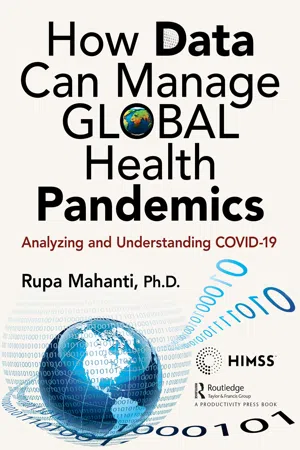
How Data Can Manage Global Health Pandemics
Analyzing and Understanding COVID-19
- 232 pages
- English
- ePUB (mobile friendly)
- Available on iOS & Android
About this book
"This book bridges the fields of health care and data to clarify how to use data to manage pandemics. Written while COVID-19 was raging, it identifies both effective practices and misfires, and is grounded in clear, research-based explanations of pandemics and data strategy….The author has written an essential book for students and professionals in both health care and data. While serving the needs of academics and experts, the book is accessible for the general reader."
– Eileen Forrester, CEO of Forrester Leadership Group, Author of CMMI for Services, Guidelines for Superior Service
"…Rupa Mahanti explores the connections between data and the human response to the spread of disease in her new book,... She recognizes the value of data and the kind of insight it can bring, while at the same time recognizing that using data to solve problems requires not just technology, but also leadership and courage. This is a book for people who want to better understand the role of data and people in solving human problems."
-- Laura Sebastian-Coleman, Author of Meeting the Challenges of Data Quality Management
In contrast to the 1918 Spanish flu pandemic which occurred in a non-digital age, the timing of the COVID-19 pandemic intersects with the digital age, characterized by the collection of large amounts of data and sophisticated technologies. Data and technology are being used to combat this digital age pandemic in ways that were not possible in the pre-digital age.
Given the adverse impacts of pandemics in general and the COVID-19 pandemic in particular, it is imperative that people understand the meaning, origin of pandemics, related terms, trajectory of a new disease, butterfly effect of contagious diseases, factors governing the pandemic potential of a disease, strategies to combat a pandemic, role of data, data sharing, data strategy, data governance, analytics, and data visualization in managing pandemics, pandemic myths, critical success factors in managing pandemics, and lessons learned. How Data Can Manage Global Health Pandemics: Analyzing and Understanding COVID-19 discusses these elements with special reference to COVID-19.
Dr. Rupa Mahanti is a business and data consultant and has expertise in different data management disciplines, business process improvement, regulatory reporting, quality management, and more. She is the author of Data Quality (ASQ Quality Press) and the series Data Governance: The Way Forward (Springer).
Frequently asked questions
- Essential is ideal for learners and professionals who enjoy exploring a wide range of subjects. Access the Essential Library with 800,000+ trusted titles and best-sellers across business, personal growth, and the humanities. Includes unlimited reading time and Standard Read Aloud voice.
- Complete: Perfect for advanced learners and researchers needing full, unrestricted access. Unlock 1.4M+ books across hundreds of subjects, including academic and specialized titles. The Complete Plan also includes advanced features like Premium Read Aloud and Research Assistant.
Please note we cannot support devices running on iOS 13 and Android 7 or earlier. Learn more about using the app.
Information
Chapter 1 Pandemic—An Introduction
“It’s been said that there are decades where nothing happens; and then there are weeks when decades happen.”—Vladimir Ilyich Lenin
Introduction
What Is a Pandemic?
Pandemic—Definitions
Characteristics of Pandemics
Large Geographic Spread

Person-to-Person Spread
High Transmission Rates and Explosiveness
Novelty
Table of contents
- Cover
- Title
- Copyright
- Dedication
- Contents
- List of Figures
- List of Tables
- Foreword
- Preface
- Acknowledgments
- About the Author
- 1 Pandemic—An Introduction
- 2 Data—Management, Strategy, Quality, Governance, and Analytics
- 3 Trajectory and Stages of a New Disease
- 4 COVID-19—A Pandemic in the Digital Age
- 5 Data and Pandemic in the Digital World
- 6 Data Analytics and Pandemic
- 7 Disease and Pandemic Potential
- 8 Pandemic and Critical Success Factors
- 9 Pandemic Preparedness and Strategies
- 10 Pandemic—Lessons Learned and Future Ahead
- Appendix A: Abbreviations and Acronyms
- Appendix B: Glossary of Terms
- Index